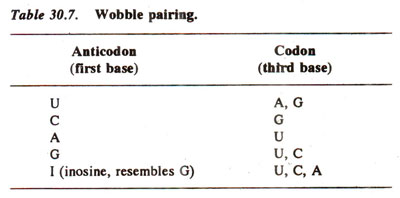It is sometimes argued that the third base of a codon is not very important and that specificity of a codon is particularly determined by the first two bases. It has been shown, for instance that the same tRNA can recognize more than one codons differing only at the third position. This pairing is not very stable and is allowed due to wobbling in base pairing at this third position.
Dr. F.H.C. Crick, in 1965 proposed a hypothesis called
Wobble hypothesis to explain this phenomenon. He discovered that if U is present at first position of anticodon, it can pair with either A or G at the third position of codon. Similar is the case with G and
I (I =
inosine is
a modified base in tRNA) found in anticodon. The pairing relationships between first base of anticodon and third base of codon are given in Table 30.7).
This kind of wobbling allows economy of the number of tRNA molecules, since several codons meant for same amino acid are recognized by same tRNA. For instance, anticodon IGC can recognize codons GCU, GCC and GCA (coding for
alanine); IGA can recognize UCU, UCC and UCA (coding for serine) and IAC can recognize GUU, GUC and GUA (coding for valine). It will be seen in the following section that in a primitive code discovered in mitochondria, the extent of wobbling is further increased, so that only 22 instead of 55 tRNAs are needed.





